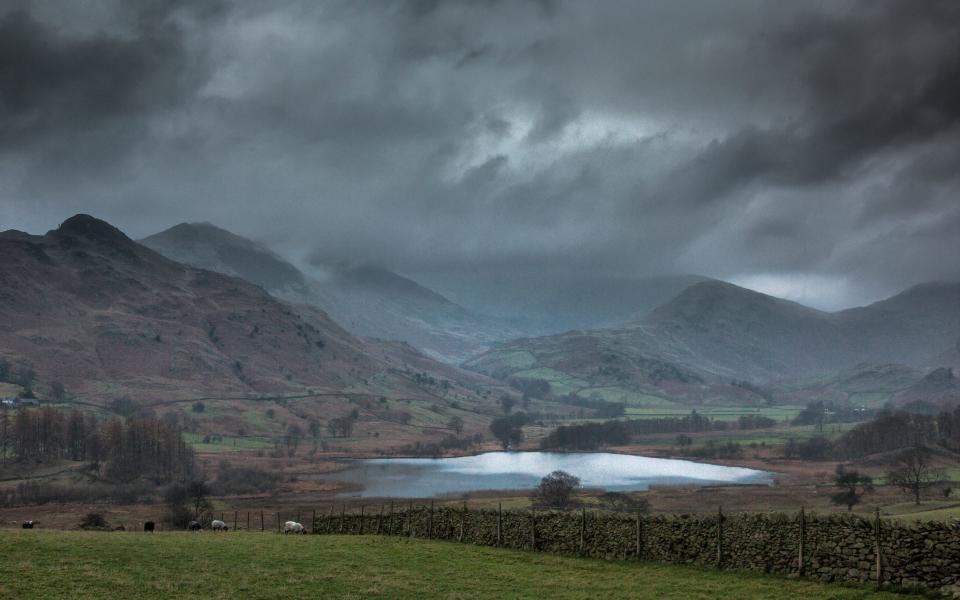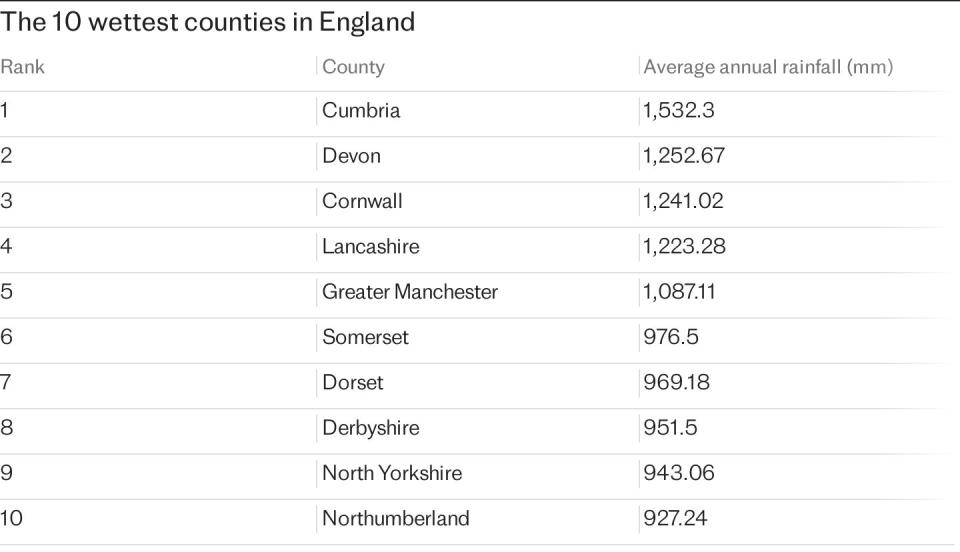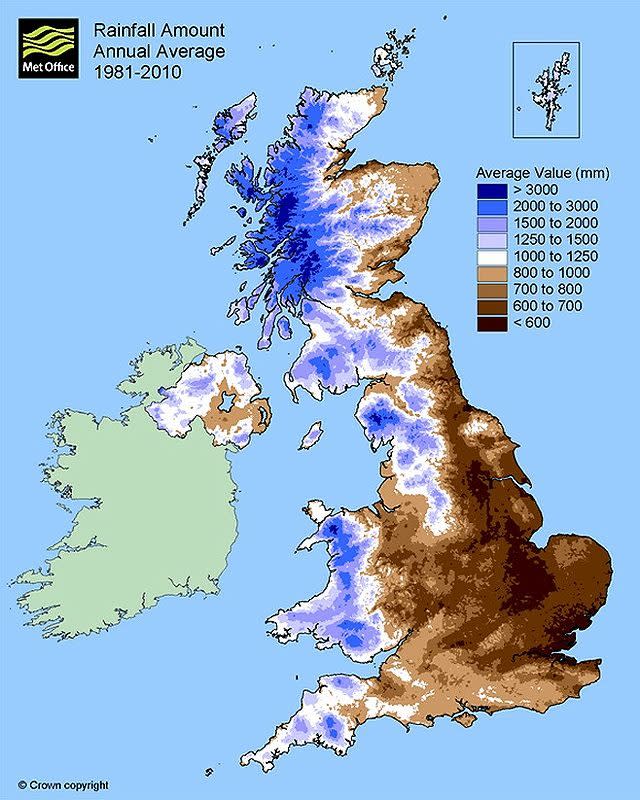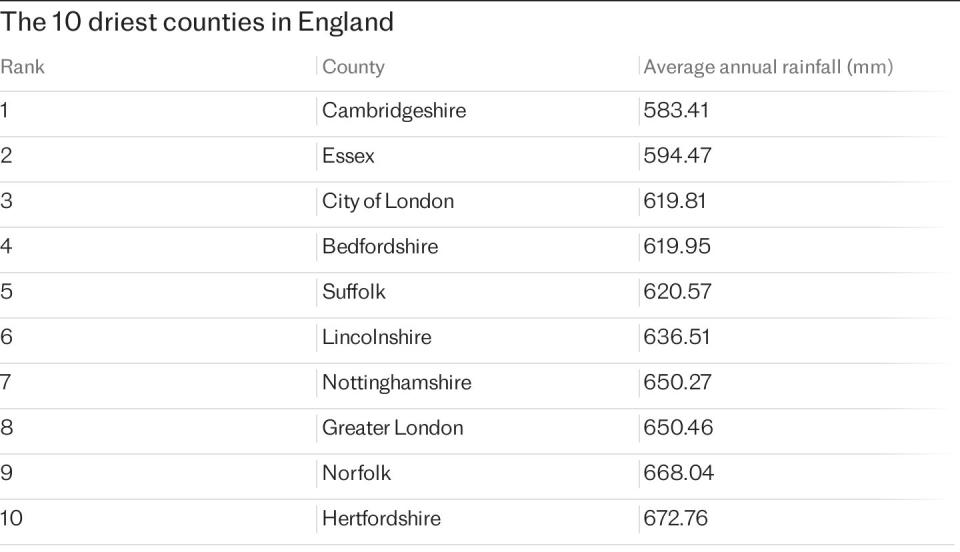“When April was in her sweet moods,” wrote Chaucer. “April is the cruellest month,” added TS Eliot.
April could go back to where it came from, I suggest.
After the winter we just had – and, to be honest, fall, and what passes for early spring – the last thing anyone needs is a “traditional April.”
But is it actually true? According to the Met Office, December is the wettest month of the year with an average of 127.19mm between 1991 and 2020. April averaged just 71.73mm over the same period.
I’ve always suspected that “April showers” are wishful thinking. We hope – against hope – that the rain will pass quickly and not become a permanent drizzle. We also stay indoors in December because it is supposed to be gloomy. Long, lighter days and blossoms now beckon us outside – and the weather doesn’t match our optimism.
We specialize in indirection and euphemism in Britain, especially when it comes to precipitation. ‘Unsettled’ is forecaster’s language for rain. ‘Changable’ ultimately means rain. ‘Unstable’ means rain, just like ‘low pressure’ or ‘complex’ or – in summer – ‘off-season’.


The English dictionary has a host of other suggestive words: mizzle, smirr, downpour, spit, chucking, slinging, throw it down. Welsh has at least 25 words of its own. Shower? What about flist, pilmer, haster, haud, plash, perry, landlash and gosling blast?
Is this deluge of words anything other than rain-weary Brits trying to make the best of a bad thing?
“It was cool and damp,” notes Paul Theroux, as he boards a train to travel the length of Britain’s coast in The Kingdom by the Sea (1983). “The weather forecast was ‘scattered showers’ – it was the forecast for Britain almost every day of the year.”
Did we come up with all the near-synonyms to make rain seem more interesting? Or at least less annoying?
Apart from ducks, droughts and gardens, rain is generally considered bad weather. It makes outdoor activities unpleasant or unfeasible. It’s not so much about the creaky, sweaty, waterproof clothes or the easily lost inside-out brolly, but about trudging along with your head bowed to the floor. The attitude of existential despair. Bend too far and the rain will pour down the back of your neck. You live without seeing the world; rain blindness. I bet Icelandic has a word for that.
Rain put an end to the Great British Holiday. ‘No rain in Portugal’, says a promotional bill from 1954. “But the tourists are pouring in.” We were all caught by posters promising Sunny Devon and Suffolk for Sunshine; there were even sunny cartoons about Aberdeenshire. From the 1970s onwards, people in Spain and Greece traded summer showers for some sunshine.


The Lake District is in constant need of replenishments. In February 2020, an average of 16mm of rain fell every day, the highest month-long runoff ever recorded (and it was a leap year). Fell walking in constant rain seems masochistic. But when I look back on my first independent adventures – hitchhiking from home near St Helens to ‘wild campsites’ (i.e. rich people’s gardens) in the Lakes – I remember the whole experience, including breaking up the camp at night due to flooding. with enormous affection.


The west is, as is known, the wettest. That top corner, from Ulster to the West Highlands, is almost always hidden behind a mass of bubbling blue in TV forecasts. What is striking, however, is the competition between places in Britain that claim to receive the greatest amount of rain. The internet is full of them, from Seathwaite in Cumbria to Martinstown in Dorset and Fort William to places all over Wales – including Cardiff, Crymych, Capel Curig and Eglwyswrw. I can vouch for the wetness of the northern half of Wales; my family holidays were all in Rhyl, Prestatyn, Colwyn Bay and Llandullas; I remember mobile homes with views over the coast – the windows were dripping and smeared with rain.


The Met Office website has a handy map of the rainiest places. Dartmoor, almost all of Wales and western Scotland all have dark blue parts – meaning that between 1981 and 2010, an average of more than four meters fell per year. The Pennines and all other high places are purple – the next category down. Extreme statistics are also given, confirming that Martinstown was indeed one day rainier than any other town in 1955, while Crib Goch on Snowdon received the most rain in a month in 2015.


Preston had its wettest five minutes on record: 32mm on August 10, 1893. Monsoon showers seem to be more common now, which could be down to climate change or, equally, my imagination.
But why should the competition be the wettest – and why does the Met Office know that we would all be left out if we didn’t know who got soaked the most and most often, and when the worst year was in such and such a place?
Is it romance again? Rain turns a simple landscape into something very beautiful. See Simon Buckley’s photo of Manchester’s Deansgate in the rain if you need proof of the transformative power of rain.
But perhaps it lies deeper than that. Melissa Harrison, who has written an entire book on the subject, notes that we instinctively respond to the feeling of rain on our skin, and to seeing how it revives streams and ‘baptizes’ dry soil. She comes even closer to the meaning of rain when she claims: “And there is something else that rain gives us; something deeper and more mysterious, that has to do with memory, and nostalgia, and a pleasant kind of melancholy.’
We humans are changeable, restless and sometimes miserable. Rain reassures us that our troubled minds are part of nature.
It defines this country more than any other type of weather. It is our identity, our home, our childhood fun and our first holiday. Once upon a time we couldn’t fly away and escape it; in this soggy-looking spring of 2024, we may have to renew our relationship with rain. Let it come down! Let it pour!
Is Britain really that rainy compared to other countries?
Colombia and Brunei are competing online for the title of wettest country in the world. Of course, regional differences mean that it is never wet all the time. López de Micay in northern Colombia has a reported – and controversial – annual rainfall of 12,892.4 mm (508 in).
According to at least one source, Bergen, Norway has taken the number one spot as the rainiest city in Europe. It receives 1,958 mm (77.1 in) of precipitation per year, or 163.2 mm (6.4 in) per month. On average, there are 231 days per year with more than 0.1 mm (0.004 in) of precipitation.
According to Guinness World Records, the place with the highest average annual rainfall is the village of Mawsynram in northeastern India, which receives almost 12,000 mm of rain per year. Located high in the Khasi Hills of India, Mawsynram is directly in the path of the warm, moist air brought in from the Bay of Bengal. Most of the rain in Mawsynram falls during the monsoon season, which lasts from April to October every year.
Guinness also says that Mount Waialeale in Hawaii has the most rainy days, with up to 350 rainy days per year.
Argyllshire in Scotland – Britain’s wettest region – receives just 2,274.9mm of rain. But Met Office hill stations have recorded much higher figures. The UK rain gauge on record with the highest average annual rainfall totals is Crib Goch (Gwynedd) with 4,635mm of rain, followed by Styhead (Cumbria) with 4,562mm.
Is April really the wettest month?
No. December is the wettest month of the year with an average of 127.19 mm between 1991 and 2020. April has an average of 71.73 mm for the same period.
The saying ‘March winds and April showers bring forth May flowers’ dates back to 1886, although the idea of April being rainy goes back centuries.
The jet stream – which is sent in showers – is notoriously fickle. Sometimes it settles in the north and we have dry April months.
Is Manchester really the wettest city in Britain?
No. South Glamorgan (Cardiff) has a slightly higher total of annual rainfall accumulation. For the period 1991-2020, an average of 1,177.81 mm of rain fell annually. Manchester had 1,087.14 mm.
However, note that when it comes to the number of rainy days, the Cardiff region had 201.93 and Manchester 214.18. The former has a greater number of days with greater rainfall accumulations.
Is the West really wetter than the East?
Yes.
The Pennines of northern England, the mountains of Wales, the Lake District and the Highlands of Scotland create a rain shadow covering most of eastern Britain, due to the prevailing south-westerly winds.
We have Atlantic rainforests to prove it. Dartmoor, West Wales and Wigan are akin to southern Chile and British Columbia in this respect.
Does the sun ever shine on Northern Ireland?
Occasionally yes, but the country is in the central track of low-pressure systems and is therefore the target of high winds and oceanic weather. Heavy westerly storms are especially common in the north and on the east coast. Above 245 meters altitude, distorted trees and windbreaks testify to the severity of the weather.
Is the British summer actually dry and sunny?
Yeah-ish. In general, places in the east and south of Britain are drier, warmer, sunnier and less windy than places further west and north. These favorable weather conditions usually occur more often in spring and summer than in autumn and winter.


Oliver Claydon from the Met Office added: “One statistic that could be of interest is that May is statistically drier than the summer months for Britain.”
The relevant statistics are: May – 70.98 mm, June – 77.2 mm, July – 82.48 mm and August – 93.73 mm.
“One thing to be aware of is that in the summer months you can get significant amounts of the monthly rainfall total in just one event with a heavy rainstorm or thunderstorm, while in May the monthly totals can be more spread out.”